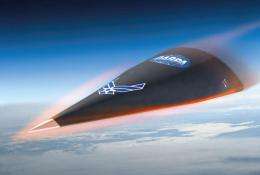US hypersonic glider flunks first test flight

US military scientists lost contact with a hypersonic glider nine minutes into its inaugural test flight last week, a defense research agency said on Tuesday.
The unmanned Falcon Hypersonic Technology Vehicle 2 (HTV-2) is designed to fly through the upper reaches of Earth's atmosphere at speeds of up to Mach 20, providing the US military with a possible platform for striking targets anywhere on the planet with conventional weapons.
The HTV-2 was launched last week aboard a Minotaur IV rocket from Vandenberg Air Force Base in California, according to the Defense Advanced Research Projects Agency (DARPA).
The test flight called for a 30-minute mission in which the vehicle would glide at high speed before splashing down in the Pacific Ocean, north of a US military test site at the Kwajalein Atoll.
The glider separated from the booster but soon after the signal vanished, a spokeswoman said.
"Preliminary review of data indicates the HTV-2 achieved controlled flight within the atmosphere at over Mach 20. Then contact with HTV-2 was lost," Johanna Spangenberg Jones, a spokeswoman for DARPA, told AFP.
"This was our first flight (all others were done in wind tunnels and simulations) so although of course we would like to have everything go perfectly, we still gathered data and can use findings for the next flight, scheduled currently for early 2011," she said in an email.
The test flight was supposed to cover a total of 4,100 nautical miles (7,600 kilometers) from lift-off and scientists had hoped to conduct some limited maneuvers, with the HTV-2 banking and eventually diving for its splash down.
US aerospace giant Lockheed Martin builds the hypersonic glider, which the military calls "revolutionary."
The hypersonic program appears to fit in with US plans to develop a way of hitting distant targets with conventional weapons within an hour, dubbed "prompt global strike."
According to a Pentagon fact sheet for the vehicle, "the US military seeks the capability to respond, with little or no advanced warning, to threats to our national security anywhere around the globe."
A hypersonic plane could substitute for a ballistic missile armed with a conventional warhead, as other countries might suspect the missile represented a nuclear attack.
"Aside from its speed, another advantage is that it would not be mistaken by Russia or China for a nuclear launch," said Loren Thompson, an analyst with the Lexington Institute who has done consultant work for Lockheed Martin.
The US Air Force has also looked at hypersonic vehicles for intelligence-gathering if spy satellites in low orbit were attacked, he said.
(c) 2010 AFP

















